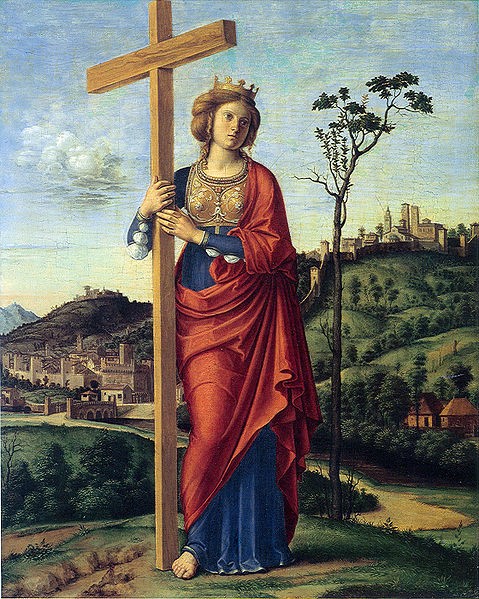This is a legend unlike any other. It all started with a young servant girl named Flavia Julia Helena.1 Born in 248 C.E. in Bithynia, a province of the Roman Empire, Helena was no different from anyone else, until the day that she caught the eye of the Roman emperor Constantius I Chlorus with her beauty.2
They married, had a son in the year 272 who, if you have ever learned anything about Roman history, you will probably know. Their son was the one and only Constantine. Constantine became one of the greatest Roman emperors. One of the things he is known for is the Edict of Milan, issued in the year 313.3 The Edict of Milan allowed for Christianity to be a freely practiced religion. It was at this time that Helena most likely converted to Christianity.4

In the year 324, Constantine sent Helena on a pilgrimage to the Holy Lands in search of the “Holy Sepulcher” and “The True Cross.” The “Holy Sepulcher” is the location of the crucifixion of Jesus Christ, while “The True Cross” is the cross on which Jesus Christ was crucified.5 On this pilgrimage, it was said that Helena “followed in the footsteps of Jesus,” by performing many acts of kindness and good works, such as giving money, food, and clothing to the poor, and also helping churches with funds as well as their other needs.6 After weeks of traveling, they finally made it to Jerusalem. With the help Judas Cyriancus, a man selected at random and forced against his will to help, Helena was able to get closer than she ever had to finding “The True Cross.”7 This is where the story diverges. Although some believe a commoner from a nearby town led Helena to “The True Cross,”others believe that it was Judas Cyriancus.
They continued their search for days, when their prayers were finally answered. Helena said it was then, “With sweet smelling dust and a flash of lighting pointed to the place where,” she instructed Judas to started digging.8 Finally, they uncovered three crosses, one thought to belong to Jesus Christ, and the others belonging to the two thieves that died alongside Him. To test and see which one of these crosses truly belonged to Jesus Christ, they searched for a leper at the outskirts of Jerusalem. Once one was found, they returned back to the site of Golgotha, the place of Jesus’ crucifixion. The leper was instructed to touch each of the crosses one by one. He touched the first one and nothing happened. He touched the second one and still nothing happened. Finally, when he touched the third and final cross, the leper was instantly healed.9 It was this cross that healed the leper, and for that reason it is known as the “The True Cross.”

The cross was then carried back to Constantinople, while part of the cross was placed in the hands of the bishop of Jerusalem.10 As the years passed, fragments of “The True Cross” were placed in the care of many Catholic churches around the world for all to admire. Although we may never know whether the cross they found and distributed was “The True Cross,” like all legends, in the end it is up to us whether to believe the account or not.
- Dictionary of World Biography, 2016 s.v. “Helena, St.” ↵
- Global Events: Milestone Events Throughout History, 2014, s.v. “Saint Helena Makes a Pilgrimage to the Holy Land,” by Jennifer Stock. ↵
- Global Events: Milestone Events Throughout History, 2014, s.v. “Saint Helena Makes a Pilgrimage to the Holy Land,” by Jennifer Stock. ↵
- Dictionary of World Biography, 2016 s.v. “Helena, St.” ↵
- New Catholic Encyclopedia, 2003 s.v. “Helena, St,” by J. H. Geiger. ↵
- Global Events: Milestone Events Throughout History, 2014, s.v. “Saint Helena Makes a Pilgrimage to the Holy Land,” by Jennifer Stock. ↵
- Barbara Baert, “New Observations on the Genesis of Girona (1050-1100). The Iconography of the Legend of the True Cross,” Gesta 38, no. 2 (1999): 117-121. ↵
- Barbara Baert, “New Observations on the Genesis of Girona (1050-1100). The Iconography of the Legend of the True Cross,” Gesta 38, no. 2 (1999): 117-121. ↵
- Barbara Baert, “New Observations on the Genesis of Girona (1050-1100). The Iconography of the Legend of the True Cross,” Gesta 38, no. 2 (1999): 117-121. ↵
- Religious Celebrations: An Encyclopedia of Holidays, Festivals, Solemn Observances, and Spiritual Commemorations, 2011, s.v. “Elevation of the True Cross (September 14),” by J. Gordon Melton. ↵



56 comments
Noah Bolhuis
This article started off choppy with seemingly poor sentence structures, but definitely resolved itself after the first paragraph. However, this story is really hard to believe factually because after around 300 years of Jesus’ death, it would be common sense that either some christian person or group would take it, or natural causes would erode most, if not all, of the three crosses. However, even if this is the true tale with no falsehoods or not, it turned out to be a good article.
Dalton Moy
I have heard of the saint named Helena, I have even been to a church that was named after her, however I never had done any research as to who she was and why she was canonized. I was not at all expecting to learn that she was the mother of Constantine. I also found it interesting that she was the one who discovered what is believed to be Christ’s cross. I had heard of the relic fragments, but I had not done much research on who had discovered it, or the story behind it. I am glad to read this article. I killed two birds with one stone. I got some background on a saint as well as the background of a holy relic.
Martina Rodriguez
I had no idea St. Helena’s last name was Helena. I also had no idea she was a mother to the son of a Roman emperor. LET ALONE CONSTANTINE! I was surprised that he sent his mother on such a long pilgrimage. Interesting how the story different about who led Helena to the cross. I liked the story of how she discovered which cross was the True Cross.
Lilliana Canales
In my opinion, I think the cross should have been left where they found it, it just seems disrespectful. I’ve never heard of St. Helena, or the “True Cross” but this article did a fine job of explaining her travels upon her sons request to find the “True Cross”. From reading this article, I learned about Constantine’s Mother who loved him so much that she traveled the same path Jesus traveled to fulfill her sons request.
Lyzette Flores
Although I am very religious I had never heard of this story. From the looks and research of it, I believe St.Helena was a very kind and humble person. She loved to help others just like Jesus Christ himself. I do believe that the cross they came across is the “true cross.” I would very much like to see this cross in person to see the beauty of it.
Stephanie Silvola
I am not a person of religion so for myself to read this article on a woman who went through a religious pilgrimage is inspiring. Helena did not have “follow in Jesus’ footsteps” nor to give out kindness in order to search for the “true cross”. This article makes me want to read more about her in general, not just of this journey. This article is written quite nicely.
Mia Stahl
The legend of the true cross is one that is very unique from all others. The way that the people spread pieces of the cross around the world for all to admire is inherent of a practice that the Catholic church still participates in today. In the case of a church being considered a basilica, it must contain the relic of a saint. In the same way, this cross was distributed as a way to give many churches a relic of “The True Cross.”
Caden Floyd
I really enjoyed reading this article about St. Helena. I had no prior knowledge of her before reading, but now I realize how great she was and how much of an impact she has had on religion. I think it is neat how she was chosen to find The True Cross, which is such a demanding task. She followed in the footsteps of Jesus being good and holy and ended up arriving at the cross. The leper part really amazed me and shows how Jesus sends us messages. I loved this article and would recommend it to anyone.
Belene Cuellar
Helena didn’t have to give out kindness on her journey to retrieve the “true cross” she could have easily avoided all of it. She helped out everyone because she wanted to and she was a very humble person who asked for nothing in return. People loved her for her kindness and generosity and she never turned anyone away. This article was well written and the writer gave out very good details about her.
Antoinette Johnson
The true cross is something I want to see. I do not whether the cross they distributed over time was the true cross, but the effort that they put into finding it was extraordinary. It was a kind act for Helena to on her way to find the true cross, help and give things to the less fortunate and the different churches. With finding the true cross, I think a lot of the time our unwavering faith leads to the acquiring of certain relics. With faith you can do and be anything.